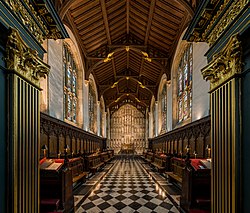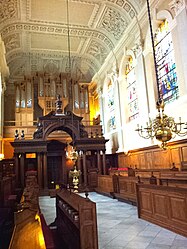William Townesend

William Townesend (1676–1739) was a prominent English sculptor, architect, and builder in 17th and 18th-century Oxford, associated with several important buildings.
His masterpiece is the Radcliffe Library in Oxford, completed by his son.
Life
[edit]

He was baptised at St Giles's Church, Oxford on 17 December 1676, the son of John Townesend the Elder (1648-1728), who was a prominent mason who served as Mayor of Oxford in 1720/1. John's wife was Elizabeth Morrell (d.1726) and William was one of four children.[1] His father was one of the main masons working on Blenheim Palace and nicknamed "Old Pincher". Townesend's eldest son, John Townesend the Younger (d.1742), was also a stonemason, with a yard in London, his most noteworthy structures being St Mary-le-Strand and the Mansion House, London.[2]
William was apprenticed to his father and would have become a Freeman mason around 1690. By 1704 he was "college mason" to Christ Church, Oxford.[3]
He died in Oxford on 22 September 1739. He is thought to be buried in the family plot in St Giles Churchyard in Oxford. His will was read on 5 October 1739, and is held in the National Archives at Kew.[4]
Family
[edit]He was married to Mary around 1703.
Their son John (1709-1746) was also a stonemason and sculptor. Following his father's death in 1739 John completed the Radcliffe Library.
Architectural works
[edit]- Remodelling at Carfax, Oxford (1707)
- Peckwater Quadrangle of Christ Church, Oxford (1709)
- Clarendon Building, Oxford (1712) under Nicholas Hawksmoor
- Chapel and Hall at Queen's College, Oxford (1714) interior and exterior
- Library at Queen's College, Oxford
- Link between Hall and Chapel (1718)
- Remodelling interior of Chapel at All Souls College, Oxford (1719)
- Altarpiece in Chapel (1719)
- Major work at Blenheim Palace with Bartholomew Peisley (1721 onwards) in place of his elderly father to the designs of Hawksmoor
- Grand Bridge at Blenheim (1721)
- Triumphal Arch (Woodstock Gate) at Blenheim (1721)
- Radley House (1721 to 1725)
- Chapel interior at Blenheim (c.1723)
- Column of Victory in Blenheim Park (1727) to the designs of Henry Flitcroft
- Hall and kitchen at All Souls College, Oxford (1729)
- Cupola at Queen's College, Oxford (1733)
- Radcliffe Camera with William Smith of Warwick (1737 until death) to the designs of James Gibbs
Monuments
[edit]- Bust of John Wallis in St Mary's Church Oxford (1703)
- Monument to Sir Thomas Powell in Llanbadarn near Aberystwyth (1706)
- Bust of David Gregory in St Mary's Church Oxford (1708)
- Monument to James and John Narborough in Oxford Cathedral (1708)
- Monument to his father John Townesend in St Giles churchyard Oxford (1728)
Gallery
[edit]-
Clarendon Building
-
All Souls College Chapel Interior, Oxford
-
Peckwater Quadrangle, Christ Church
-
Chapel at Queen's College, Oxford
-
Woodstock Gate, Blenheim Palace
References
[edit]- ^ "Collection: Archive of the Townesend family | Bodleian Archives & Manuscripts".
- ^ ODNB: William Townesend
- ^ Dictionary of British Sculptors 1660-1851 by Rupert Gunnis p.400
- ^ "Will of William Townesend, Mason of Oxford, Oxfordshire".





